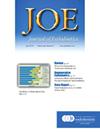不移植牙髓干细胞的CCR3拮抗剂在犬牙髓再生中的应用
IF 3.5
2区 医学
Q1 DENTISTRY, ORAL SURGERY & MEDICINE
引用次数: 0
摘要
我们之前的研究表明,将牙髓干细胞(DPSCs)与趋化因子受体3 (CCR3)拮抗剂联合移植到老年狗的根管中可以促进牙髓再生。在这项研究中,我们尝试使用CCR3拮抗剂在没有DPSC移植的情况下再生幼犬的牙髓。方法:拔牙后4周,支架材料和CCR3拮抗剂(KDH-136)进入根管内,对犬的牙齿进行组织学观察。体外研究KDH-136对RAW264.7细胞炎症反应的影响。此外,我们还研究了KDH-136是否影响PC12细胞的神经突生长。结果:KDH-136的应用使牙髓样组织形成。此外,观察神经和血管再生。KDH-136抑制RAW264.7细胞的趋化因子产生,促进神经生长因子刺激的PC12细胞的神经突生长。结论:CCR3拮抗剂可能有助于开发不需要DPSCs移植的牙髓再生新方法。本文章由计算机程序翻译,如有差异,请以英文原文为准。
Dental Pulp Regeneration in Dogs Using a Chemokine Receptor 3 Antagonist Without Transplantation of Dental Pulp Stem Cells
Introduction
Our previous study showed that transplantation of dental pulp stem cells in combination with a chemokine receptor 3 (CCR3) antagonist into the root canals of aged dogs promoted dental pulp regeneration. In this study, we attempted to regenerate dental pulp in young dogs using a CCR3 antagonist without dental pulp stem cell transplantation.
Methods
The teeth of dogs were histologically evaluated 4 weeks after extraction of the pulp and administration of scaffold materials and CCR3 antagonist (KDH-136) into the root canal. The effects of KDH-136 on the inflammatory response of RAW264.7 cells were investigated in vitro. In addition, we also examined whether KDH-136 affected neurite outgrowth of PC12 cells.
Results
Application of KDH-136 resulted in the formation of dental pulp-like tissue. Furthermore, nerve and blood vessel regeneration were observed. KDH-136 suppressed chemokine production from RAW264.7 cells and promoted nerve growth factor-stimulated neurite outgrowth of PC12 cells.
Conclusions
CCR3 antagonists may be useful for developing novel methods of dental pulp regeneration that do not require transplantation of dental pulp stem cells.
求助全文
通过发布文献求助,成功后即可免费获取论文全文。
去求助
来源期刊

Journal of endodontics
医学-牙科与口腔外科
CiteScore
8.80
自引率
9.50%
发文量
224
审稿时长
42 days
期刊介绍:
The Journal of Endodontics, the official journal of the American Association of Endodontists, publishes scientific articles, case reports and comparison studies evaluating materials and methods of pulp conservation and endodontic treatment. Endodontists and general dentists can learn about new concepts in root canal treatment and the latest advances in techniques and instrumentation in the one journal that helps them keep pace with rapid changes in this field.
 求助内容:
求助内容: 应助结果提醒方式:
应助结果提醒方式:


